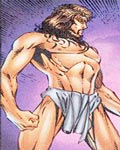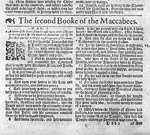Piety and Dreams Sire a Godman
Was Jesus, like Alexander the Great or Julius Caesar, a real historical figure to whom legends and myths became attached? Or, rather, like Huckleberry Finn or Sherlock Holmes a purely fictional character, passed off as a genuine personage or later historicized by other hands?
Common Error
No one “just made-up” Jesus. If we step around the centuries of fabrication and glorification which informs everyone’s perception of Jesus Christ and closely examine the two hundred year gestation period of the current Lord and Saviour we can see a perfectly plausible and, indeed, convincing process by which, upon the legacy of earlier times and from piety and scripture alone, the Christian godman emerged into the light. Beliefs created the man; the man did not create the beliefs.
Jewish History in a Nutshell –
The birth of Judaism – following the collapse of the northern kingdom of Israel – enshrined the myths of Moses, Joshua, David and Solomon as sacred race heroes. But the theocrats had hardly begun their fantasizing when they were overtaken by events. During the 6th century BC the priestly elite found itself exiled in Babylon. A generation later, with the Persian overthrow of the Babylonians, the die was cast again. Now the “saviour” of the Jews was a Persian king, Cyrus the Great, whose imperial designs were served by a theocratic colony in Judah.
"The Anointed Shepherd"
Thus saith the LORD to his anointed, to Cyrus, whose right hand I have holden, to subdue nations before him; and I will loose the loins of kings, to open before him the two leaved gates; and the gates shall not be shut.”
– Isaiah 44.24,28; 45
The Maccabean Revolution – Religion in Ferment
Around 142 BC, about the time that the Greek garrison finally withdrew from the citadel in Jerusalem, Simon Maccabeus assumed the positions of both High Priest and “ethnarch” – a priest/king of unlimited power. The Zadokites were not best pleased.
Essenes – "Righteous Teacher, Son of Man"
From Daniel they took the phrase “one like a man” and rendered a new title for their soon-to-arrive hero “Son of Man”, he who would usher in God’s Kingdom and restore the rightful bloodlines.
Shock and Awe
– War Scroll 11.4,9.
Pharisees – "Universal King, Raising the Dead"
II Maccabees, written about this time, recorded the sentiments of the Pharisees. To the Pharisees belongs the dubious honour of inventing the concept of Holy War, a conviction that faith will lead the righteous into martyrdom and that it is their martyrdom which will prompt God to act.
God vouchsafed a new eternal life to his martyrs.
Alexander's Massacre – "Scapegoat Sacrifice"
– Josephus, Antiquities of the Jews, 13.14.
Initially the Elect had been stunned and shocked by the execution of their Righteous Teacher. To the Essenes, Alexander was the “Lion of Wrath,” his tyranny a time of trial. But on the other hand it was also a sure sign of the “Last of Days”. Such is the nature of creative piety, from the setback the priests were able to fabricate a positive spiritual riposte: the notion of a propitiatory sacrifice.
– Allegro, The Dead Sea Scrolls, p90.
Seeing God? Theophany goes out of fashion, Prophesy reigns
Today, of course, He would probably use a web-cam.
Updating 'Isaiah' – "Suffering Servant"
– Isaiah 53
Sources:
- J. R. Porter, The Lost Bible (Duncan Baird, 2001)
- John Allegro, The Dead Sea Scrolls and the Christian Myth (Westbridge, 1979)
- M. Baigent, R. Leigh, The Dead Sea Scrolls Deception (Jonathan Cape, 1992)
- Don Fleming, Bible Knowledge Dictionary (Scripture Press, 1990)
- Luigi Cascioli, The Fable of Christ (Luigi Cascioli, 2001)
- David Watson, Jesus, then and Now (Lion, 1983)
- W. P. Ball, et al, The Bible Handbook (AAP, 1986)
- Nicholas Carter, The Christ Myth (Historical Review Press, 1993)
- Keith Hopkins, A World Full of Gods (The Free Press, 2000)

Dead Sea Scrolls

First "Christ"?

... versus Rabid Extremist
“Let everybody who is zealous for the law and stands by the covenant follow me”
From the Dead Sea Scrolls


The Jewish "Alexander"
“I shall see him, but not now: I shall behold him, but not nigh: there shall come a Star out of Jacob, and a Sceptre shall rise out of Israel, and shall smite the corners of Moab, and destroy all the children of Sheth.”
– Numbers 24.17.

Golgotha – Place of Skulls
From the "Damascus Document"

From the Dead Sea Scrolls
– lQpHab 12.7-9







